This story is part of a series taking a look inside the unique Longview Power coal-fired power plant in West Virginia. In this installment, SNL Energy examines the technology behind one of the cleanest and most efficient coal plants in Longview's operating region. In the  second installment, SNL Energy focuses on the advantages offered by a practically on-site coal mine and the benefits of the mine-mouth model.
second installment, SNL Energy focuses on the advantages offered by a practically on-site coal mine and the benefits of the mine-mouth model.
Just south of the Pennsylvania border in Maidsville, W.Va., one of the nation's newest and most efficient coal-fired power plants is getting back on its feet after a brief stumble. Fresh off reorganization, Longview Power LLC now seeks to demonstrate the capabilities of a modern coal-fired power plant from within the Appalachian coalfields.
| 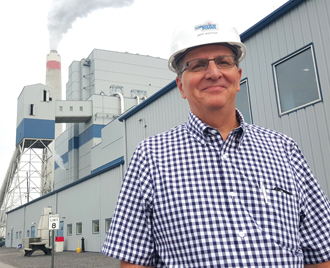
Jeffery Keffer, president and CEO of Longview Power, said the plant is one of the cleanest and most efficient in the country. Photo credit: Taylor Kuykendall |
The plant got off to a rough start. At a cost of roughly $2.0 billion, the proposed project was the largest private investment in West Virginia history. The 700-MW plant commenced operations in 2011, but hit a wall when construction defects resulted in a plant not ready for primetime in an unsupportive market.
The result was a company sidled with debt and operating under severe limitations on its ability to pay that debt back. Since then, the company has repaired issues at the plant, including problems with the boiler, generator and its air pollution controls, and an order from the U.S. Bankruptcy Court for the District of Delaware  confirmed Longview's restructuring
confirmed Longview's restructuring  plan early in 2015.
plan early in 2015.
"Our focus has been on other things, so it's great to be in position to have the plant up and running in the manner that it was supposed to in the first place," Longview President and CEO Jeffery Keffer told SNL Energy ahead of a tour of Longview.
With bankruptcy behind it, the power plant is now under new leadership led by private equity firms including KKR Credit Advisors (US) LLC, Centerbridge Partners LP, American Securities LLC and Third Avenue Management LLC. In addition to some of the most clean and efficient technologies for burning coal, the power plant is equipped with a number of other advantages such as the ability to avoid costly transportation fees for its coal supply — a nearby mine is operated by Longview's affiliate, Mepco Holdings LLC, and feeds coal directly to the plant via conveyor belt.
'Not your dad's coal plant'
At the heart of the Longview power plant is several critical pieces of technology. A Siemens steam turbine system capable of spinning at 3,600 rotations per minute with a steam flow of roughly 5 million lbs/hour transfers thermal energy from combusting coal into a Siemens generator that converts that energy into electricity that is pumped onto the grid for consumer and industrial use.
| 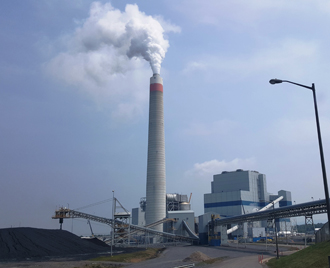
The Longview Power plant uses a 700-MW advanced supercritical boiler just south of the Pennsylvania border in Maidsville, W.Va. Photo credit: Taylor Kuykendall |
The "centerpiece" of Longview power plant, however, is its advanced supercritical pulverized coal boiler that drives the plant's high efficiency by pushing water into a supercritical state — meaning there is no clear distinction between the liquid and gas phase of the water — using high levels of pressure and heat. Operators of the plant carefully designed the plant to maintain efficiency wherever possible and closely monitor inputs into the system.
"This is really not your granddad's coal plant. It's not your dad's coal plant," said Stephen Nelson, senior vice president of operations at Longview. "It is truly a fully integrated modern plant."
Nelson has spent his life around all sorts of power stations and said Longview "is unique in very, very positive ways." Controls on the boiler, what Nelson said is likely among the most sophisticated in North America, give the operators very tight control on air and fuel input, allowing the plant to operate with fewer emissions than many other coal plants.
"It really is a great, innovative system," Nelson said. "Sometimes we wonder if the rest of West Virginia followed suit, what things would really look like."
The question is an important one in the state. West Virginia is the largest coal producer in the eastern United States and in 2014, coal-fired power was responsible for over 95% of the state's net electricity generation according to the U.S. Energy and Information Administration.
A recent SNL Energy  analysis of the final Clean Power Plan showed that West Virginia was among the states the furthest from complying with the rule. Assuming a business-as-usual approach, the state would need to adjust by 35% its emissions rate based on 2020 projections to make the 2030 goals outlined in the plan.
analysis of the final Clean Power Plan showed that West Virginia was among the states the furthest from complying with the rule. Assuming a business-as-usual approach, the state would need to adjust by 35% its emissions rate based on 2020 projections to make the 2030 goals outlined in the plan.
 Established,
Established,  new and
new and  proposed regulations affecting emissions of mercury, particulate matter, nitrogen oxides, carbon dioxide and more mean that, increasingly, older coal plants cannot economically
proposed regulations affecting emissions of mercury, particulate matter, nitrogen oxides, carbon dioxide and more mean that, increasingly, older coal plants cannot economically  operate or compete. Particularly in today's low-cost natural gas environment, many power plants are finding it easier to shutter their coal plants or convert them to natural gas than to continue burning coal.
operate or compete. Particularly in today's low-cost natural gas environment, many power plants are finding it easier to shutter their coal plants or convert them to natural gas than to continue burning coal.
| 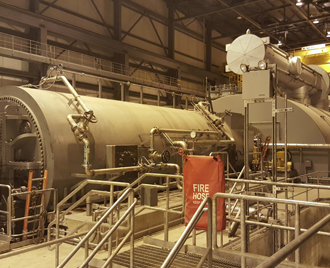
Longview Power generates electricity using one of the most modern turbine and generator assemblies available. The equipment is made by Siemens. Photo credit: Taylor Kuykendall |
"If you look at a lot of power plants that have to retrofit all that — those plants aren't really designed to take that retrofit," Nelson said. "Whereas, right off the drawing board, this was designed to have an integrated emissions control which goes to our ability get very low emissions and our ability to do it with a very low heat rate. We have a really good result because we came right off the board with the way a modern coal plant needs to be designed."
Just down the road from Longview is Fort Martin, a power plant built in the late 1960s and owned by FirstEnergy Corp. Nelson said as an example, you can visually spot the differences in the emissions from Longview and Fort Martin stacks.
"On a really nice day, when you compare our plume, to say our neighbor's, we don't have a brown cloud," Nelson said. "It comes out and it's almost all pure water vapor."
This is achieved by a series of mechanisms at the plant including measures taken before, during and after combustion. Before being released into the air, emissions from the plant are pushed through baghouse filters, a flue gas absorber, and a selective catalytic convertor.
Longview's permit limits for air emissions are by far the lowest in West Virginia.
"It's not like we're dancing on a fine line," Keffer said. "We're easily making those permit levels."
In large part because it was designed with environmental controls in mind, the power plant also boasts the most efficient coal-fired unit in the region. As of 2012, a Longview presentation states, the average net heat rate of the PJM coal fleet was about 10,600 Btu/kWh. Longview is designed to run at a heat rate of 8,728 Btu/kWh, or about 18% more efficient than the average coal plant.
What happened?
The road to Longview is dotted with signs from local  opposition criticizing the plant, though Keffer said much of the
opposition criticizing the plant, though Keffer said much of the  resistance against the project has settled as the company has stepped up to support local community safety and outreach programs and otherwise settled into the community. However significant the opposition from those who did not want another coal plant in their backyards, technical concerns and a fundamental shift in energy markets would ultimately prove a larger
resistance against the project has settled as the company has stepped up to support local community safety and outreach programs and otherwise settled into the community. However significant the opposition from those who did not want another coal plant in their backyards, technical concerns and a fundamental shift in energy markets would ultimately prove a larger  hurdle to the plant.
hurdle to the plant.
In a  statement released in 2013, Longview said it would have to file for bankruptcy protection along with its coal-mining affiliate Mepco Holdings. The company blamed contractor failures for the plant only being able to achieve a 68% capacity factor since it took possession of the plant in late-2011. In addition, the plant faced numerous forced outages, extended planned outages, generation derating and even boiler tube leaks.
statement released in 2013, Longview said it would have to file for bankruptcy protection along with its coal-mining affiliate Mepco Holdings. The company blamed contractor failures for the plant only being able to achieve a 68% capacity factor since it took possession of the plant in late-2011. In addition, the plant faced numerous forced outages, extended planned outages, generation derating and even boiler tube leaks.
| 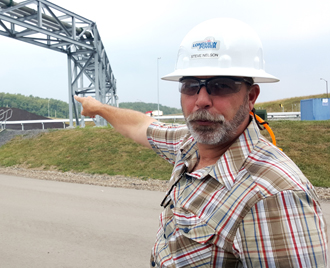
Stephen Nelson, senior vice president of operations at Longview, points out coal inventories during a tour of the Longview Power plant facility. Photo credit: Taylor Kuykendall |
Keffer said that because few coal plants were being built at the time, a lot of the institutional knowledge that goes into a plant's construction was not available during construction.
"As a result, we got a plant that really wasn't ready for primetime," Keffer said.
Longview faced numerous operational challenges, aggravated by the  unforgiving market for coal the debt-laden company found itself in while trying to solve these challenges. The sudden glut of natural gas and subsequent price drop doomed many coal
unforgiving market for coal the debt-laden company found itself in while trying to solve these challenges. The sudden glut of natural gas and subsequent price drop doomed many coal  projects while other factors have led to various levels of financial woe for new coal
projects while other factors have led to various levels of financial woe for new coal  projects such as the Peabody Energy Corp.-backed FutureGen 2.0 or Southern Power Co.'s Kemper
projects such as the Peabody Energy Corp.-backed FutureGen 2.0 or Southern Power Co.'s Kemper  project, both aiming to capture carbon dioxide.
project, both aiming to capture carbon dioxide.
"When they started construction of this, the Marcellus [shale] was just starting to be tapped and people had no idea it would be as successful as it was," Keffer said. "As a result, you have this huge amount of natural gas supply. … It just totally changed the market. … The combination of [operational and market issues] was the perfect storm where we couldn't sustain the amount of debt that was taken on to build the plant."
Once filing for bankruptcy protection, Longview was able to locate $150 million in debtor in possession  financing, allowing it to restructure its construction debt and provide the repairs needed to get the plant back on its feet.
financing, allowing it to restructure its construction debt and provide the repairs needed to get the plant back on its feet.
Longview also went into arbitration with its contractors and reached a settlement to save potential costs. The court  approved the
approved the  settlement and the upgrade of an air pollution control device Longview reported was frequently experiencing a pressure drop that cost the plant on efficiency and limited the plant's capacity to produce electricity.
settlement and the upgrade of an air pollution control device Longview reported was frequently experiencing a pressure drop that cost the plant on efficiency and limited the plant's capacity to produce electricity.
Now, the plant has emerged restructured and touts 100 power plant jobs, 500 coal mining jobs and gross wages and benefits from both operations totaling around $70 million. The company touts its project as "good for West Virginia and the U.S." by not only offering local employment and tax revenue, but also by displacing older technology and going beyond its permit limitations while providing "low cost, highly reliable electricity to the region."
Looking toward the future
| 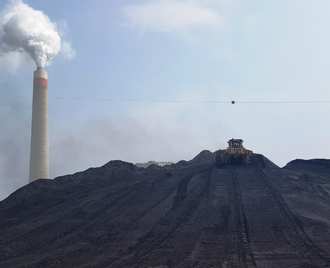
Longview Power's coal mining subsidiary pushes coal along a pile located near the plant. The exact mixture and specification of coal is closely monitored and blended as it is sent to the power plant. Photo credit: Taylor Kuykendall |
The plant is profitable in a market currently weighted heavily against coal. If natural gas prices go up, things could be even better. Nelson said this is likely to happen in the not-so-distant future, particularly as a lot of large, older coal plants are replaced by natural gas. Much of the coal fleet operating in the PJM Interconnection is over 35 years old, with a large chunk of coal capacity coming from units that are more than 50 years old.
"When you start putting in gas-fired units that are 500 to 800 megawatts a piece — that's a lot of gas," Nelson said. "It doesn't take that many to really start to move the market on the price of gas."
Keffer said that the many advantages of the plant — from its efficient technology to its supply advantages — means it can compete very well. He said that while people have gotten used to very low natural gas prices, and that is likely to continue for a while, gas will eventually find new markets and its current low price is unlikely to be sustainable.
When gas prices become less palatable to consumers, Longview's hope is that it can lead the way in showing what a modern coal plant can do. The plant, Keffer said, is "very different" and "so much more advanced than even other supercritical coal-fired power plants.
"This is a very unique and different asset," Keffer said. "We can produce low-cost and reliable power and we can do it in an environmentally friendly way."
If President Barack Obama's Clean Power Plan goes through unscathed, Longview may still not meet the requirements necessary to get under potential plant-level emissions levels, a fact that has  not escaped rating agencies eyeing the company's financials. However, the plant will be among the few coal plants with a relatively small gap between its emissions and the cap, limiting the amount of credits needed if such a system were implemented.
not escaped rating agencies eyeing the company's financials. However, the plant will be among the few coal plants with a relatively small gap between its emissions and the cap, limiting the amount of credits needed if such a system were implemented.
Keffer said there is not much point to arguing about efforts to reduce carbon dioxide emissions.
"The issue is, how do you deal with it? How do you deal with it with the resources you have? … Clearly coal is taking it on the chin … but I think people looking for the longer term, and even the EPA knows, coal is here and we're going to continue to use it," Keffer said. "We have a tremendous resource here — the question is, how do you use it in a way that is environmentally compatible with our goals as a nation?"

